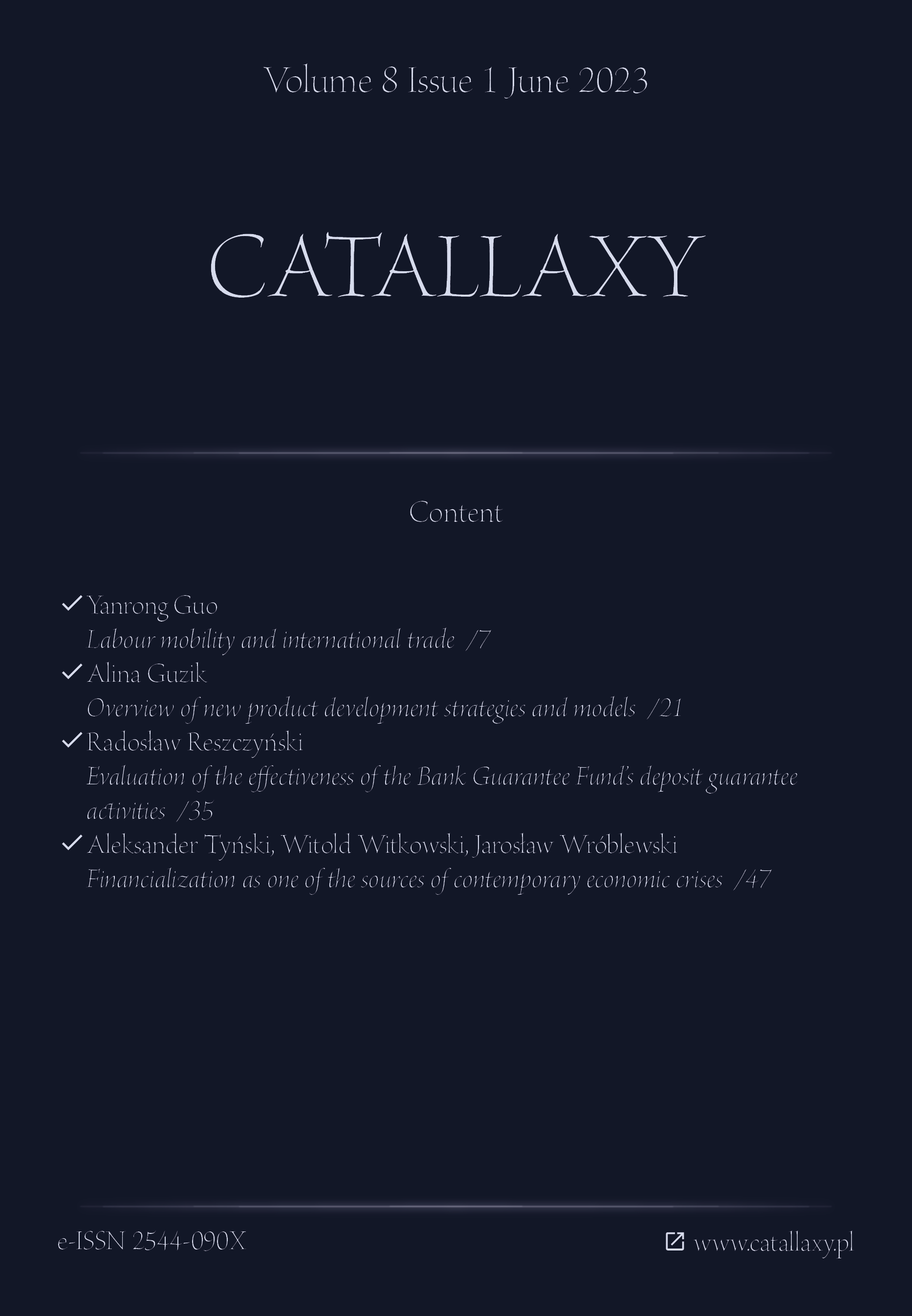Labour mobility and international trade
DOI:
https://doi.org/10.24136/cxy.2023.001Keywords:
international trade, dispatched labour, labour mobilityAbstract
Motivation: The academic debate on whether the relationship between factor mobility and international trade is one of complementarity or substitution is inconclusive. In general, the relationship between the two can vary depending on the specific research methodology and the object of study. Moreover, there are fewer empirical analyses with China and the European Union as subjects, so studying the relationship between labour mobility and trade in the case of China and Europe is worthwhile.
Aim: The purpose of this paper is to determine, through empirical analysis, the relationship between labour mobility in the form of dispatched labour and bilateral trade between China and the European Union in the period of 2005-2021.
Materials and methods: This paper utilises quantitative analysis to investigate the relationship between labour movements and trade (imports and exports) based on data from 2005 to 2021, primarily through co-integration analysis and Granger causality testing.
Results: The study found that there is a substitution relationship between the number of dispatched labour from China and the trade in goods between China and the European Union in the research period. Additionally, Granger causality tests show that China's dispatched labour to the EU is the Granger cause of China-EU export trade, and vice versa. However, China's dispatched labour to the EU is not a Granger cause of China-EU import trade.
Downloads
References
Bhagwati, J.N., Brecher, R.A., Dinopoulos, E., & Srinivasan, T.N. (1987). Quid pro quo foreign investment and welfare: a political-economy-theoretic model. Journal of Development Economics, 27(1-2), 127-138. https://doi.org/10.1016/0304-3878(87)90010-1.
Bruder, J. (2004). Are trade and migration substitutes or complements: the case of Germany 1970-1998. European Trade Study Group, September, 9-11.
Collins, W., O'Rourke, K., & Williamson, J. (1999). Were trade and factor mobility substitutes in history. In R. Faini, J. De Melo, & K. Zimmermann (Eds.), Migration: the controversies and the evidence (pp. 227-260). Cambridge University Press. https://doi.org/10.1017/CBO9780511628405.017.
Dunlevy, J.A., & Hutchinson, W.K. (1999). The impact of immigration on American import trade in the late nineteenth and early twentieth centuries. The Journal of Economic History, 59(4), 1043-1062. https://doi.org/10.1017/S002205070002413X.
Eurostat. (2023). China-EU: international trade in goods statistics. Retrieved 12.04.2023 from https://ec.europa.eu/eurostat/statistics-explained/index.php?title=China-EU_-_international_trade_in_goods_statistics.
Genc, M., Gheasi, M., Nijkamp, P., & Poot, J. (2012). The impact of immigration on international trade: a meta-analysis. In P. Nijkamp, J. Poot, & M. Sahin (Eds.). Migration impact assessment (pp. 301-337). Edward Elgar. https://doi.org/10.4337/9780857934581.00019.
General Administration of Customs of the People's Republic of China. (2023a). Imports and exports by country (region) of origin/destination,12.2022. Retrieved 05.04.2023 from http://english.customs.gov.cn/Statics/2d05960c-26ca-453b-b7b6-ce4d7af378b1.html.
General Administration of Customs of the People's Republic of China. (2023b). Monthly bulletin: imports and exports by country (region) of origin/destination. Retrieved 05.04.2023 from http://english.customs.gov.cn/statics/report/monthly.html.
Goldberg, L.S., & Klein, M.W. (1997). Foreign direct investment, trade and real exchange rate linkages in developing countries. NBER Working Paper Series, 6344, 1-41. https://doi.org/10.3386/w6344.
Goldberg, L.S., & Klein, M.W. (1999). International trade and factor mobility: an empirical investigation. NBER Working Paper Series, 7196, 1-28. https://doi.org/10.3386/w7196.
Gould, D.M. (1994). Immigrant links to the home country: empirical implications for U.S. bilateral trade flows. The Review of Economics and Statistics, 76(2), 302-316. https://doi.org/10.2307/2109884.
Head, K., & Ries, J. (2001). Overseas investment and firm exports. Review of International Economics, 9(1), 108-122. https://doi.org/10.1111/1467-9396.00267.
Helpman, E., & Krugman, P. (1987). Market structure and foreign trade: increasing returns, imperfect competition, and the international economy. MIT Press.
Jacks, D.J. (2005). Immigrant stocks and trade flows, 1870-1913. Journal of European Economic History, 34(3), 625-649.
Kojima, K. (1973). A macroeconomic approach to foreign direct investment. Hitotsubashi Journal of Economics, 14(1), 1-21. https://doi.org/10.15057/8008.
Krugman, P. (1995). Increasing returns, imperfect competition and the positive theory of international trade. In G.M. Grossman, & K. Rogof (Eds.), Handbook of international economics, 3, 1243-1277. Elsevier. https://doi.org/10.1016/S1573-4404(05)80004-8.
Lipsey, R.E., & Weiss, M.Y. (1981). Foreign production and exports in manufacturing industries. The Review of Economics and Statistics, 63(4), 488-494. https://doi.org/10.2307/1935843.
Markusen, J.R. (1983). Factor movements and commodity trade as complements. Journal of International Economics, 14(3), 341-356. https://doi.org/10.1016/0022-1996(83)90009-0.
Markusen, J.R., & Svensson, L.E. (1983). Trade in goods and factors with international differences in technology. NBER Working Paper Series, 1101, 1-28. https://doi.org/10.3386/w1101.
MOFCOM. (2023). China-Europe economic and trade relations. Retrieved 05.04.2023 from http://ozs.mofcom.gov.cn/article/zojmgx/?.
Mundell, R.A. (1957). International trade and factor mobility. The American Economic Review, 47(3), 321-335.
National Bureau of Statistics of China. (2012). Explanatory notes on main statistical indicators. Retrieved 05.04.2023 from http://www.stats.gov.cn/sj/ndsj/2012/html/zbe06.htm.
National Bureau of Statistics of China. (2022). China statistical yearbook: volume 2005-2022. Retrieved 05.04.2023 from http://www.stats.gov.cn/sj/ndsj.
Neary, J.P. (1995). Factor mobility and international trade. The Canadian Journal of Economics. Revue Canadienne d'Economique, 28, S4-S23. https://doi.org/10.2307/136168.
Pain, N., & Wakelin, K. (1998). Export performance and the role of foreign direct investment. The Manchester School, 66(S), 62-88. https://doi.org/10.1111/1467-9957.66.s.4
Pfaffermayr, M. (1996). Foreign outward direct investment and exports in Austrian manufacturing: substitutes or complements. Weltwirtschaftliches Archiv, 132(3), 501-522. https://doi.org/10.1007/BF02707510.
Preibisch, K.L. (2007). Local produce, foreign labour: labour mobility programs and global trade competitiveness in Canada. Rural Sociology, 72(3), 418-449. https://doi.org/10.1526/003601107781799308.
Purvis, D.D. (1972). Technology, trade and factor mobility. The Economic Journal, 82(327), 991-999. https://doi.org/10.2307/2230263.
Svensson, L.E.O. (1984). Factor trade and goods trade. Journal of International Economics, 16(3), 365-378. https://doi.org/10.1016/S0022-1996(84)80013-6.
Xiong, T., & Sun, H. (2021). Structure and dynamics of global capital and international trade: analysis of the relationship between exports and foreign direct investment (FDI) from 2001 to 2006. International Journal of Finance & Economics, 26(1), 542-559. https://doi.org/10.1002/ijfe.1803.
Downloads
Published
How to Cite
Issue
Section
License
Copyright (c) 2023 Catallaxy

This work is licensed under a Creative Commons Attribution 4.0 International License.





